FR / EN
visitor's itinerary
The "real" musketeers
In 1622, Louis XIII, at that time at war against the Protestants, detached the 50 soldiers armed with carbines from the companies of his guard’s lighthorse cavalry to form an independent unit. These soldiers were armed with a musket, a heavy weapon that could only be used on foot, but they were still cavalry who moved around on horseback. Called Musketeers of the Guard, a military branch of the Maison du Roi, they wore the famous blue tabard decorated with the cross and Fleurdelys, the symbol showing that they belonged to the King’s Household. The character of the musketeer mounted footsoldiers made very varied missions a possibility: escorting the royal retinue, policing operations and maintaining order but, above all, they were in the first line of the royal troops when it meant relieving a town under siege. In 1693, Louis XIV ceased to go to war and, from then on, the companies only took part in special cases. This period marked the end of the musketeers’ golden age, when they served in the last campaigns of Louis XIV but were rarely seen on the battlefield during his successor’s reign. During the eighteenth century, their mission mainly consisted in a guard and prestige service to the king. They were exposed to enemy fire one last time during the War of the Austrian Succession (1740–48). In 1775, the two companies were disbanded for budgetary reasons. Formed again briefly under the Restoration, they were definitely disbanded in 1815.
-
The Barracks of the "Grey Musketeers"
1/7 
Robert de Cotte Agency.
Elevation of the Hôtel of the Grey Musketeers, rue du Bac, Paris France, circa 1720.
Paris, Bibliothèque nationale de France, Département des Estampes et de la Photographie.
Inv.: R. de C. 1035 / Fossier 19.13In 1659, King Louis XIV ordered the construction of a building for his company of Musketeers. This elite corps was the first unit to be housed in barracks. -
Hand embroidered cross
of a Musketeer’s tabard2/7 This cross is made entirely in embroidery with gold and silver thread. We believe that this particular cross was snewn on the back of the garment. 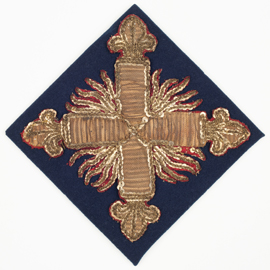
Eighteenth century, France.
Paris, musée de l’Armée
Inv.: 0353 / Gb 349/d -
Broadsword and scabbard
of a Musketeer of the Second Company3/7 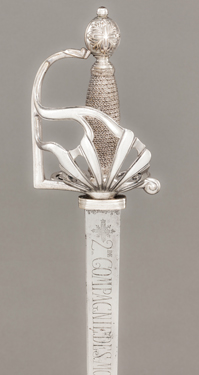
France, c. 17601770.
Paris, musée de l’Armée
Inv.: 04495/172 -
Joseph Parrocel and the FrancoDutch War in the Hotel des Invalides
4/7 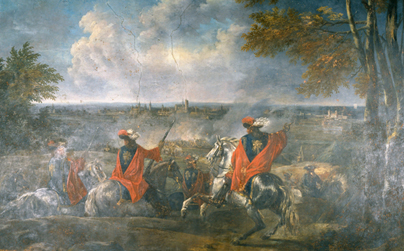
In 1680, French Secretary of State for War, the Marquis de Louvois entrusted Joseph Parrocel to work on the decoration of the nowadays Salle Royale – a programme sets out to highlight the campaigns of Louis XIV, with scenes of conquest entitled Conquêtes du Roy Louis le Grand aux années 1676-1677-1678. Parrocel also completed the paintings in the three remaining dininghalls of the Hotel that had been initially commissioned to : Jacques-Antoine Friquet de Vauroze, Michel II and JeanBaptiste Corneille. In 2005, these mural paintings were fully restored thanks to the support of the CIC Bank. Following these major restoration works, the cycle of scenes of conquest with scenes that had totally disappeared under whitewash since the eighteenth century, can be admired again. Today, we can look at the French supply lines brought to the city of Maastricht besieged by the troops of the Prince of Orange in 1676 and the Musketeers during the Siege of Ghent in 1678. -
Portrait of a Musketeer
of the Second Company5/7 This portrait depicting a Musketeer of the Second Company reveals the young age of the musketeers. 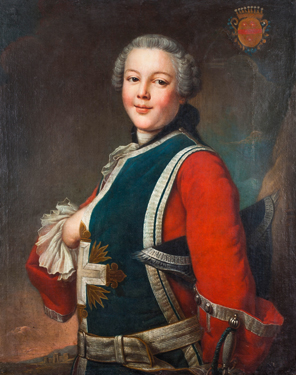
Anonymous. France.
Oil on canvas, c. 1750.
Paris, musée de l’Armée 24071 / Ec 1200 -
Illustrations of the book Divers exercices
de cavalerie (Various cavalry drills)6/7 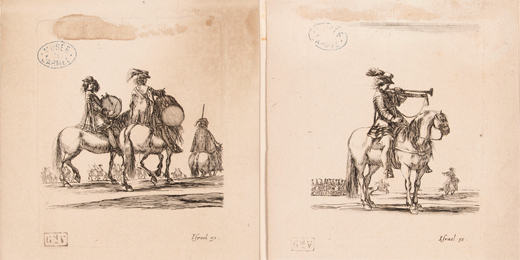
Stefano della Bella. Engraver : Israël Sylvestre the Younger.
Cavalier et musiciens des mousquetaires. Etching, 1640-1646.
Paris, Musée de l’Armée. 2013.0.1474. -
Full dress uniform of a Musketeer
of the Second Company7/7 Following the First Restauration of 1814, an attempt was made to recreate the Maison Militaire du Roi (the military household of the King of France). During the period commonly referred to as the Hundred Days (March 1st to July 7, 1815 marking the time between Napoleon’s return from exile and the Second Restauration), all the officers attached to the Maison Militaire du Roi were placed under arrest and the two Musketeers companies dismissed. Upon the return of Louis XVIII, the Musketeers were definitely disbanded on September 1, 1815. The illustrious French painter Théodore Géricault who met Alexandre Dumas only a few days before his death in 1824, was one of last Musketeers. 
France, 1814.
Paris, musée de l’Armée
Inv.: Gb 347 (helmet) ; Gb 318 (uniform) ; Gb 314 (tabard).




